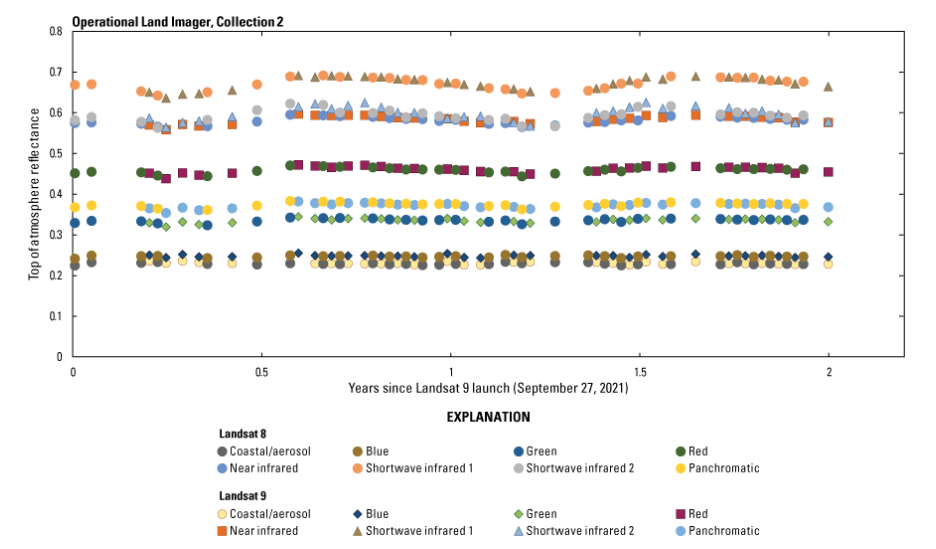Calibration and Validation Quarterly Reports Now Include Landsat 9 Analysis
The USGS Earth Resources Observation and Science (EROS) Calibration and Validation (Cal/Val) Center of Excellence (ECCOE) focuses on improving the accuracy, precision, calibration, and product quality of remote-sensing data.
The recently published ECCOE Landsat Quarterly Calibration and Validation Report—Quarter 3, 2023 (covering July, August, and September 2023), contains, for the first time, Landsat 9 analysis results. Even though the satellite was launched two years prior, adding Landsat 9 information to these reports was dependent on the April 2023 effort to reprocess the entire Landsat 9 data archive (taking advantage of calibration updates identified since launch), and to also allow enough time to elapse to begin formulating lifetime trends.
Leveraging years of multiscale optical system geometric and radiometric calibration and characterization experience, the ECCOE Landsat Cal/Val Team (CVT) continually monitors the geometric and radiometric performance of active Landsat missions and makes calibration adjustments as needed to ensure the highest level of data quality at all times. The CVT then publishes the analysis in reports that can be found on the ECCOE Landsat Calibration/Validation webpage.
The following Landsat 8 and 9 on-orbit radiometric and geometric performance metrics are included in the reports:
- Signal-to-Noise Ratio (SNR) for each OLI spectral band
- Noise Equivalent Delta-Temperature (NEDT) of two TIRS spectral bands
- Lifetime radiometric stability for each OLI and TIRS spectral band
- Detector relative gains
- Landsat 9 to Landsat 8 cross calibration (See image below.)
- Band –to-band (B2B) geometric registration accuracy
- TIRS to OLI sensor to sensor alignment
- Absolute geometric positional accuracy
- Geodetic accuracy
For Landsat 7, radiometric analysis includes compiling information from three onboard calibrators, along with the use of Pseudo Invariant Calibration Sites (PICS) to monitor radiometric stability. Coherent Noise is also monitored, and geodetic and band registration accuracy are measured. The satellite’s orbital drift outside of the World Reference System-2 (WRS-2) is continually monitored to quantify the quality of the data.
All published quarterly reports can be found on the ECCOE Landsat Calibration/Validation webpage and within the USGS Publications Warehouse.
Any questions about this or previously published ECCOE Landsat Quarterly Calibration and Validation Reports can be sent to landsat@usgs.gov or eccoe@usgs.gov.
Get Our News
These items are in the RSS feed format (Really Simple Syndication) based on categories such as topics, locations, and more. You can install and RSS reader browser extension, software, or use a third-party service to receive immediate news updates depending on the feed that you have added. If you click the feed links below, they may look strange because they are simply XML code. An RSS reader can easily read this code and push out a notification to you when something new is posted to our site.


